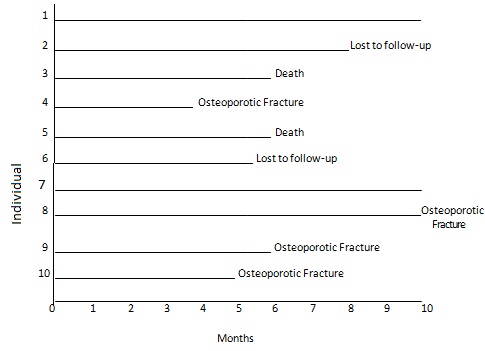Assignment:
1. Complete the following equation using the order of operations.
25*2 - 62/(16+2) - 4
a. 0.78
b. 48
c. 44
d. 0
2. Complete the following equation using the order of operations.
((9+7)-5) × 22 -48/2
a. 44
b. 40
c. 20
d. 5
A study from Baltimore, Maryland wants to study the differences in initiation of tobacco use between adolescents that started working for pay and adolescent that did not work. 150 high school students were followed in each group and it was recorded whether or not they started tobacco use.
3. True or False: The "exposure" is whether or not adolescents worked for pay.
4. True or False: The "disease" (i.e. outcome) is known at the beginning of the study.
5. What kind of study is being conducted?
a. Case-Control
b. Cross-Sectional
c. Prospective Cohort
d. RCT
A doctor wants to research the effects of smoking while pregnant on the birthweight of the newborn, i.e. does smoking while pregnant lead to abnormally small birthweights. The birthweight of 508 hundred newborns were first identified as having a normal or abnormal birthweight. The new mothers were then interviewed about their tobacco usage while pregnant. Below are the results.
Abnormal Birthweight Normal Birthweight Total
|
|
Abnormal Birthweight
|
Normal Birthweight
|
Total
|
|
Mother smoked at least once a week
|
52
|
34
|
86
|
|
Mother did not smoke at all
|
71
|
251
|
322
|
|
Total
|
123
|
285
|
508
|
6. What kind of study design is this?
a. Case-Control
b. Case Report
c. Cross-Sectional
d. RCT
7. True or False: The "exposure" is the birthweight.
8. Using the data from questions 6 - 7, what is the odds ratio of a women giving birth to a child with abnormally small birthweight if she smoked at least once a week during pregnancy compared to if she didn't smoke at all during pregnancy? (Round to 2 decimal places.) (3 pts)
a. 2.72
b. 5.40
c. 3.51
d. 0.37
A small cohort study consisting of 10 women over the age of 50 with low bone density were followed for 10 months. Below are the clinical outcomes per patient per month.

9. What is the prevalence of osteoporotic fractures at 7 months assuming once a woman develops a fracture, she continues to have it for the remainder of the study period? (Round to 2 decimal points.)
a. 0.1
b. 0.2
c. 0.3
d. 0.4
10. What is the cumulative incidence at 10 months? (Round to 2 decimal points.)
a. 0.2
b. 0.4
c. 0.6
d. 0.8
11. What is the incidence rate of developing an osteoporotic fracture in 10 months per 10,000 person-months?
a. 571
b. 500
c. 714
d. 936
A study looking at the relationship between tanning and cancer invited 100 participants to report on their tanning and melanoma history. Below are the results.
|
|
Melanoma
|
No Melanoma
|
Total
|
|
Tanned at least twice a week
|
37
|
18
|
55
|
|
Doesn't tan at all
|
20
|
25
|
45
|
|
Total
|
57
|
43
|
100
|
12. What is the prevalence of melanoma in those who have had no history of tanning? (Round to 2 decimal points.)
a. 0.44
b. 0.45
c. 0.57
d. 0.20
13. What is the prevalence of melanoma in those who had a history of tanning at least twice a week? (Round to 2 decimal points.)
a. 0.57
b. 0.67
c. 0.55
d. 0.37
14. What is the relative risk of melanoma in those who tanned at least twice a week versus those with no history of tanning?
a. 2.57
b. 3.63
c. 1.52
d. 0.55
15. What percent of melanoma cases could potentially be preventable if the participants no longer tanned at least twice a week (i.e. what is the PAR?)? (Round to 2 decimal places.
a. 0.44
b. 0.57
c. 0.23
d. 0.77